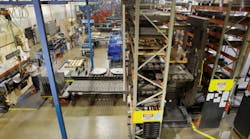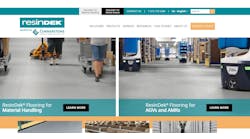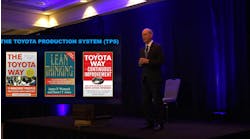Crown Equipment Corp. prides itself on being vertically integrated -- so much so that the New Bremen, Ohio-based lift-truck maker views its products as an integral part of the company's manufacturing process.
At Crown's assembly and distribution center in New Bremen, for example, you won't find a chain conveyor system driving the four assembly lines. In fact, you won't find a chain conveyor system.
Instead, Crown employees use the company's pallet trucks -- modified with adjustable platforms -- as workstations within assembly cells.
See Also: Manufacturing Innovation & Product Development Strategy
"At the beginning of the day, we know how many trucks we're going to make," explains Dave Beddow, vice president of manufacturing operations, who notes that the average seniority at the plant is 28 years. "We know what the takt time is. So we don't need a conveyor to prod our employees. These guys know what they're doing. They know what they have to do over the course of the day."
At a Crown manufacturing facility in Celina, Ohio -- about 20 miles northwest of New Bremen -- welders uses Crown fork trucks as work platforms that ergonomically position parts for grinding.
"It's very easy to use -- it's just up and down -- and we don't have a lot of fixed moving parts other than the fork itself," explains Ben Knapke, unit manager for the Celina plant, during a recent plant tour. "When you're done, you just take [the part] to the next operation, pick up your next one and bring it [into the grind booth]."
Patented Process
The Celina plant has obtained a patent for its unique approach to employing the Crown TSP 6000-Series turret stockpicker on the factory floor.
Following a concept commonly found in warehouses and distribution centers -- build up rather than spread out -- the plant has consolidated previously disparate welding, brake-press, warehousing and material handling functions into one 20,000-square-foot manufacturing cell, which produces lift-truck doors and covers.
The TSP 6000 retrieves flat sheet stock from vertical racks that stretch almost to the ceiling, and then feeds the stock to one of the two press-brake stations in the cell, via conveyors that are rigged to enable the operators to feed materials to themselves.
Once the press-brake operator is finished forming the material, he sends it back to the TSP 6000. The stockpicker grabs the material -- along with any other components that go with the order -- takes it further down the line to a welding station and drops it on a conveyor.
"The conveyor system is set up such that it has an operator-controlled hydraulic unit that'll teeter it up and down and roll the parts to the welder," explains Knapke. "The welder will complete the operation, send it back into the [stockpicking] area, and turn on one of the andon lights.
"Green means that he's good. Yellow means there's finished product to pick up, or he needs inbound material because he's ready for his next job."
The patented process applies the concept of cube utilization, a common space-maximization configuration found in distribution centers. The process not only has saved floor space, according to Crown, but also has helped the plant reduce inventory by 33%, boost productivity and improve on-time delivery.
It's also been a boon to Crown's sustainability efforts. The consolidated cell eliminates the need to transport parts between two Crown facilities, saving more than 20,000 transportation miles and 27 tons of greenhouse gases per year, according to the company.
The plant is implementing the process in a cell that makes components for lift-truck masts, Knapke points out.
"We plan to operate it in the exact same manner so that our machining operators can trigger their workload as well," he adds.
Vertical Integration
The 860,000-square-foot Celina plant is one of 16 Crown manufacturing facilities, most of which produce parts and components such as motors, drive units and electronic modules for Crown lift trucks. All of them are ISO-certified, Beddow notes, and all of them are configured to enable one-piece flow.
Crown designs and manufactures 85% of its lift-truck components, according to the company.
Crown's assembly plant in New Bremen "will trigger signals" to the Celina plant, for example, "and we'll make the kanban replenishment for them," Knapke explains.
"We'll kick off the manufacturing process here, and within 24 hours return finished product to the assembly plant," he says.
Nowhere is Crown’s vertical integration more evident than in the sleepy town of New Bremen, where brothers Carl and Allen Dicke founded the company in 1945. Carl’s grandson, James Dicke II, now serves as chairman and CEO, and James Dicke II's son, James Dicke III, serves as president. Crown owns a number of buildings throughout New Bremen, including several restaurants and a theater.
Located about an hour north of Dayton, New Bremen is home to Crown’s corporate offices as well as a 1.6 million-square-foot assembly plant and engineering, machining, R&D, rapid-prototyping, training and distribution facilities.
Just 15 minutes away (in opposite directions) are Fort Loramie, Ohio, where Crown makes wire harnesses and electronic assemblies; and New Knoxville, Ohio, where Crown produces motors and plastic components.
With many lift-truck orders requiring customization, Crown’s vertical integration enables the company to be flexible and to more easily accommodate special requests and changes, Beddow says.
InfoLink
In Celina and in the rest of Crown's manufacturing facilities, you'll find operators and managers using InfoLink, a wireless system on Crown lift trucks that provides real-time data on equipment usage, battery status, fuel consumption and other information.
Crown appreciates InfoLink for the same reasons that its customers do, asserts Beddow. For example, the system requires each lift-truck operator to scan his or her badge and complete a checklist of safety and maintenance items before activating a truck.
If the operator isn't certified to run the truck, or if the operator doesn't complete the items on the checklist, the lift truck won't start. And that's exactly the kind of safeguard that Crown wants in its operations.
"We designed InfoLink," Beddow says. "We program it. We built the equipment and the hardware. We're a user of our own stuff."




